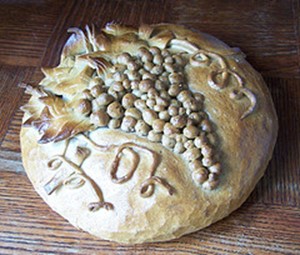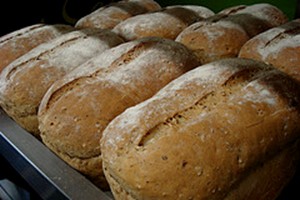If a perfume company could bottle the smell of freshly baked bread, I swear it would be a hit. What man on earth could possibly resist that smell, but it’s a smell found in too few kitchens these days.
Bread-baking isn’t exactly a lost art, but when moms are rushing from Point A to Point B and beyond every day, picking up a loaf of Roman Meal is the simplest option, to say the least. However, for those of us who have decided to stock up on wheat, we’ve gotta learn what to do with all that wheat and making homemade bread is at the top of the list!
An everyday, practical skill
Yep, baking a loaf of bread from scratch. Now, to some of you this is so old-hat that you’re already bored. What we need from you, though, are easy, no-fail recipes, tips on making the perfect loaf, etc. We really need voices of experience! And, I’m challenging you to add a new bread recipe or skill to your repertoire. Have you made your own sourdough starter? Have you tried mixing different types of wheat? How about experimenting with baking bread in a solar cooker or over a campfire? Try something new this month, and tell us about it!
Here’s an assignment for our advanced students…
image by zakwitnij
If you’re new to bread baking, you can start with recipes that call for all-purpose or bread flour. We won’t make you grind your own wheat, but if you’re ready to take the plunge, buy a pound or two of hard-white wheat, scour eBay or Craigslist for a “starter” wheat mill, and then get going! You can try out the basic recipe found in this article.
Everyone is welcome to share recipes, websites, YouTube videos and any other resources you discover along the way. If our grandmothers and great-grandmothers could master the art of baking bread, then so can we!
If you have a bread maker, you can use that handy appliance to mix your dough using the ‘dough’ setting. Once the dough is ready, remove it from the bread maker, knead, form your loaf, and let it rise for thirty minutes before baking. If this is your usual routine, then ditch the bread maker and mix the whole darn thing with your two hands!
Why this skill?
image by net_efekt
In terms of practical survival, bread is great as a meal stretcher, and once you find a recipe you really like, the ingredients are easily memorized. The ingredients for bread are easily found in any grocery store, except the actual wheat, and are all very economical.
I believe that wheat will never be cheaper than it is right now. My favorite source of wheat, Honeyville Farms, has been out of hard white wheat for about three weeks now and prices have been steadily rising. If you’re not sure where to buy wheat, try contacting a nearby Mormon/LDS church and ask them for help. They might know of local growers or farmers who deliver to your area. Some of my blog sponsors, such as Emergency Essentials and Ready Made Resources, sell wheat. Shop around, compare prices and shipping charges, but this is a good time to jump into purchasing wheat, starting with Hard White Wheat.
Tip: If you’re purchasing wheat in five gallon buckets, you can plan on getting around 35-40 loaves of bread per bucket.
Start now to make sure you are staying prepared.
Via: thesurvivalmom






 Follow
Follow


